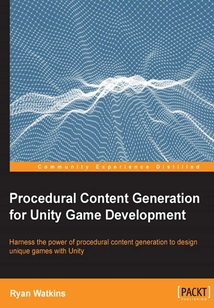首頁(yè) > 計(jì)算機(jī)網(wǎng)絡(luò) >
編程語(yǔ)言與程序設(shè)計(jì)
> Procedural Content Generation for Unity Game Development最新章節(jié)目錄
目錄(86章)
倒序
- 封面
- 版權(quán)頁(yè)
- Credits
- Disclaimer
- About the Author
- About the Reviewers
- www.PacktPub.com
- Support files eBooks discount offers and more
- Preface
- What this book covers
- What you need for this book
- Who this book is for
- Conventions
- Reader feedback
- Customer support
- Chapter 1. Pseudo Random Numbers
- Introducing PCG
- Usage of PCG
- Application of PCG
- Pseudo random numbers
- Random versus pseudo random numbers
- Challenge
- Summary
- Chapter 2. Roguelike Games
- An introduction to Roguelike games
- Why Roguelike?
- Our own Roguelike project
- Setting up the project
- Summary
- Chapter 3. Generating an Endless World
- Data structure choice
- PCG algorithm overview
- Scene setup
- Initial Game Board
- Summary
- Chapter 4. Generating Random Dungeons
- Algorithm design
- Data structures
- DungeonManager
- BoardManager
- Player
- GameManager
- Back to the Unity Editor
- Seeding the dungeon
- Challenge
- Summary
- Chapter 5. Randomized Items
- Generating health items in the game world
- Generating items in the dungeon
- Summary
- Chapter 6. Generating Modular Weapons
- PCG with modules
- Modular weapon scripts
- Adding a spawn point
- Adding a weapon pick up
- Adding scripted weapon animation
- Adding character facing directions
- Summary
- Chapter 7. Adaptive Difficulty
- Setting up sprites
- Adding enemies to the world board
- Adding enemies to the Dungeon Board
- Fighting the enemy
- Adaptive difficulty
- Summary
- Chapter 8. Generating Music
- Concept of music
- Summary
- Chapter 9. Generating a 3D Planet
- Adding a third dimension
- Multi mesh planet
- Exploring the planet
- Summary
- Chapter 10. Generating the Future
- Models
- Items
- Levels
- Texture
- Terrain
- Physics
- Animation
- AI
- Story
- The player sandbox
- Summary
- Index 更新時(shí)間:2021-07-16 09:42:30
推薦閱讀
- Functional Python Programming
- 數(shù)據(jù)庫(kù)程序員面試筆試真題與解析
- Visual C++實(shí)例精通
- Learning ArcGIS Pro
- Spring實(shí)戰(zhàn)(第5版)
- 微信小程序全棧開發(fā)技術(shù)與實(shí)戰(zhàn)(微課版)
- Babylon.js Essentials
- Getting Started with Python and Raspberry Pi
- Hands-On GUI Programming with C++ and Qt5
- 愛上C語(yǔ)言:C KISS
- ABAQUS6.14中文版有限元分析與實(shí)例詳解
- Advanced Python Programming
- 深度學(xué)習(xí)程序設(shè)計(jì)實(shí)戰(zhàn)
- Python 快速入門(第3版)
- Instant GLEW
- Getting Started with hapi.js
- Java EE基礎(chǔ)實(shí)用教程
- 軟技能2:軟件開發(fā)者職業(yè)生涯指南
- SQL Server 2014數(shù)據(jù)庫(kù)設(shè)計(jì)與開發(fā)教程(微課版)
- C語(yǔ)言程序設(shè)計(jì)教程
- C語(yǔ)言開發(fā)入門教程
- Kotlin for Enterprise Applications using Java EE
- Neural Networks with R
- 計(jì)算機(jī)應(yīng)用基礎(chǔ)實(shí)驗(yàn)指導(dǎo)(第二版)
- 構(gòu)建高質(zhì)量軟件:持續(xù)集成與持續(xù)交付系統(tǒng)實(shí)踐
- 計(jì)算機(jī)網(wǎng)絡(luò)技術(shù)及應(yīng)用
- PHP+MySQL動(dòng)態(tài)網(wǎng)頁(yè)設(shè)計(jì)
- Python深度學(xué)習(xí)從原理到應(yīng)用
- Effective Debugging:軟件和系統(tǒng)調(diào)試的66個(gè)有效方法
- Mastering Machine Learning with scikit-learn(Second Edition)


